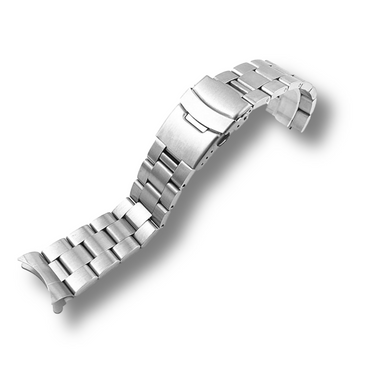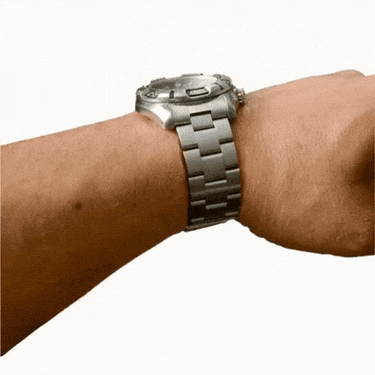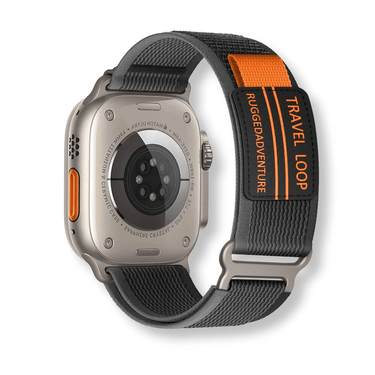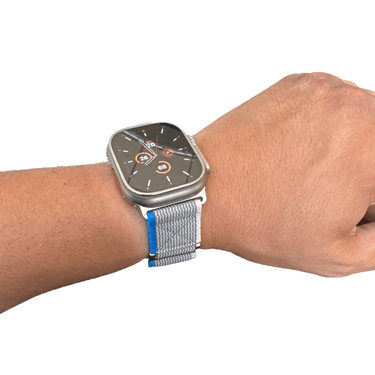The Importance of Sustainable Fashion
Sustainability is a buzzword that has been thrown around quite a lot in recent years, and for good reason. Climate change is real, and it is happening at an alarming rate.
The fashion industry is one of the largest contributors to pollution and waste. The production of clothing and accessories requires significant amounts of natural resources, energy, and water.
It also generates greenhouse gases that contribute to climate change. As consumers, we have a responsibility to make conscious choices when it comes to the products we buy.
We need to start paying attention to what goes into the making of our clothes, shoes, and accessories. Sustainable fashion seeks to minimize the negative impact that the fashion industry has on the environment by using eco-friendly materials, reducing waste and carbon emissions.
A Brief Overview of Sustainable Watchbands
Watchbands are often overlooked when it comes to sustainability in fashion because they seem like such small components in comparison to other items like clothing or footwear. However, they are just as important as any other accessory that we wear on a daily basis. Sustainable watchbands are typically made from eco-friendly materials such as recycled plastic bottles or cork.
They are designed with minimal environmental impact in mind so that they do not harm our planet during their production or disposal. These watchbands can be found in various styles ranging from casual rubber bands for sports watches all the way up through fancy leather straps for dress watches.
The Rise of Sustainable Watchbands
The rise of sustainable watchbands is a testament to how much consumers care about sustainability in their everyday lives now than ever before. People want products that align with their values and beliefs - they don't just want something fashionable; they want something that does not harm our planet while being fashionable.
The shift towards sustainable products may seem small at first glance but it's having a big impact on how brands operate. It's forcing them to rethink how they produce goods, and it's also making them more accountable for the environmental impact that their products have.
Thesis Statement
Sustainable watchbands are a perfect example of how fashion can be both stylish and environmentally friendly at the same time. As consumers, we need to start paying attention to the materials that go into making our accessories if we want to reduce our impact on the environment.
The rise of sustainable watchbands shows that manufacturers are listening and are willing to change their ways for the betterment of our planet. Sustainable fashion is not just a trend; it's a way of life that we all need to adopt in order to protect the future of our planet.
The Environmental Impact of Traditional Watchbands
Explanation of the materials used in traditional watchbands and their impact on the environment
Have you ever stopped to think about the materials used in traditional watchbands? Most are made from leather, rubber or metal, which come with a variety of environmental impacts.
Leather is a byproduct of the meat industry and requires significant resources to produce, including land for grazing and water for tanning. Rubber comes from trees that are typically grown in monoculture plantations that displace native forests and have devastating impacts on biodiversity.
Metal watchbands require mining activities that lead to deforestation, soil erosion, and water pollution. Not only are these materials environmentally destructive, but they also harm animals.
Leather production leads to animal suffering as cows are often raised in cramped conditions with little access to sunlight or space to move around. Rubber extraction can also be damaging as it requires tapping sap from trees repeatedly which can harm them over time.
Discussion on how traditional watchbands contribute to pollution and waste
The production process involved in creating leather watch straps involves harsh chemicals like chromium and formaldehyde which pollute nearby water sources during tanning. The use of pesticides on rubber plantations also has negative environmental consequences as these chemicals release toxins into surrounding ecosystems. In addition, traditional watchbands contribute significantly to waste because they have a limited lifespan due to their low durability.
Since most watches require replacement bands every few years, this means that millions of discarded bands end up in landfills each year - further contributing to pollution. It's time for us all to consider whether we need traditional watchbands at all when there are much more sustainable alternatives available!
The Emergence of Sustainable Watchbands
Overview of Sustainable Materials Used in Watchbands
Sustainable watchbands have emerged as a popular trend in the fashion industry, and for good reason. These watchbands are made from a variety of sustainable materials, such as recycled plastic, cork, and organic cotton. Recycled plastics are an excellent choice for watchband material because they reduce the amount of waste going to landfills or oceans.
Plus, they can be made into any color or texture to match any fashion statement. Cork is another sustainable option that has become increasingly popular.
Cork oak trees can be harvested without harming the tree, making it an eco-friendly resource that grows back quickly. Organic cotton is another trending material that is grown without the use of harmful pesticides and chemicals.
Produced with Minimal Environmental Impact
Not only are sustainable watchbands made from environmentally friendly materials, but they are also produced with minimal environmental impact. The production process for traditional watchbands involves significant amounts of water usage and energy consumption contributing to greenhouse gas emissions in addition to chemical discharge during leather tanning process leading to water pollution.
In contrast, manufacturers producing sustainable watch bands prefer eco-friendly manufacturing processes; this includes using renewable energy sources like solar power or recycled water during production. Moreover, ethical concerns surrounding labor rights are mitigated when supporting brands that produce sustainably sourced products (watch bands included).
Child labor is a common problem among low-income families who cannot afford basic necessities such as education or healthcare; these issues perpetuate poverty cycles while also being detrimental to human rights as well as animals’ welfare standards. The emergence of sustainable watchbands shows how fashion companies can contribute their fair share towards earth preservation by transitioning toward more ethical environmental practices while still satisfying consumer demand for trendy accessories.
A Call To Action
It's time we all take a stand and change the way we consume fashion products. The rise of sustainable watchbands is a step in the right direction, but it's important to remember that there is still a long way to go.
Fashion companies must adopt sustainable practices across all aspects of their business, from sourcing materials to manufacturing processes. As consumers, we have a responsibility to choose brands that prioritize sustainability and ethics over fast fashion trends.
By supporting companies that produce sustainable watchbands, we are sending a message to the industry that sustainability is not just a passing fad - it's the future of fashion. Let us embrace this new age of sustainability in fashion by supporting brands who prioritize eco-friendly practices; together we can make meaningful progress towards reducing our environmental footprint while also promoting human rights and ethical labor standards.
The Benefits of Sustainable Watchbands
Going Green: Promoting Environmental Conservation
It's no secret that our planet is in dire need of conservation efforts, and the fashion industry has been a major contributor to environmental destruction. The production of traditional watchbands involves the use of materials like leather and plastic that are harmful to the environment.
Not only do these materials contribute to pollution, but they also require intensive energy and water usage during production. Sustainable watchbands offer an alternative that promotes environmental conservation.
For instance, WeWOOD utilizes recycled wood to create their watchbands. This means they are preventing trees from being cut down while also reducing waste by giving new life to previously used materials.
Additionally, Sprout Watches produces watchbands made from biodegradable materials such as corn resin and organic cotton. This approach ensures that even at the end of a watchband's lifespan, it will decompose naturally without polluting the environment.
A More Ethical Alternative: The Case for Sustainable Watchband Production
The fashion industry has been criticized heavily for its labor practices throughout its supply chain. It's not uncommon for workers in developing countries to be paid low wages with poor working conditions in order to produce cheaper products. Sustainable watchband production offers a more ethical alternative by prioritizing fair labor practices throughout its supply chain.
Brands like Sprout Watches have committed themselves to responsible sourcing and manufacturing protocols that aim to protect worker rights and ensure fair pay. Furthermore, promoting sustainable business practices can have a ripple effect on other industries within the fashion sector.
By supporting sustainable brands through purchasing decisions, consumers can help shift industry norms towards more ethical manufacturing processes overall. Overall, choosing sustainable watchbands is a conscious decision towards supporting environmentally-friendly initiatives while also promoting ethical supply chain practices within the fashion industry.
Sustainable Watchband Brands Making a Difference
An Introduction to Notable Brands
Sustainability has become an increasingly important issue in the fashion industry, and sustainable watchbands have emerged as one of the most popular ways for consumers to make a positive impact. While there are many brands producing sustainable watchbands, two in particular stand out: WeWOOD and Sprout Watches.
WeWOOD is an Italian brand that produces watches made entirely from recycled or reclaimed wood. They claim their watches are not only environmentally friendly, but also hypoallergenic and free from toxic chemicals.
Sprout Watches, on the other hand, uses eco-friendly materials such as corn resin and bamboo to create their timepieces. Both brands have received praise for their commitment to sustainability.
WeWOOD: A Brand Committed to Sustainability
WeWOOD's commitment to sustainability goes beyond just using recycled wood to make their watches. They also partner with nonprofit organizations such as American Forests and Trees for the Future, pledging that for every watch sold they will plant a tree in areas affected by deforestation. In addition, they use minimal packaging made from recycled paper and do not use any plastic in their products or shipping materials.
While some may argue that using wood for watches is not truly sustainable since it involves cutting down trees, WeWOOD sources all of its wood from offcuts from furniture manufacturers or old buildings that would otherwise be thrown away. Furthermore, they use only fast-growing trees like maple or blackwood, which can be harvested without causing long-term damage to the environment.
Sprout Watches: Leading the Way with Eco-Friendly Materials
Sprout Watches is another brand leading the charge when it comes to sustainable watch production. Their timepieces are made primarily from corn resin - a biodegradable material made from cornstarch - and feature straps made from bamboo or organic cotton.
They also use mercury-free batteries and recycled packaging. But Sprout Watches doesn't stop at just producing eco-friendly timepieces.
The brand also partners with organizations like the Green Schools Alliance to promote sustainability education in schools. They have even created a program where customers can send back their old Sprout Watches to be recycled, reducing the amount of waste that ends up in landfills.
The Impact of Sustainable Watchband Brands on the Fashion Industry
While sustainable watchbands may seem like a small part of the fashion industry, brands like WeWOOD and Sprout Watches are making a big impact. By prioritizing sustainability, they are setting an example for other companies to follow and showing consumers that it is possible to create products that are both fashionable and environmentally friendly. In addition, these brands are helping to shift consumer attitudes towards sustainable fashion.
Consumers are becoming more aware of the impact their purchases have on the environment, and as a result there has been a growing demand for sustainable alternatives in all areas of fashion - including watches. WeWOOD and Sprout Watches are two notable brands leading the way in sustainable watch production.
Their commitment to using eco-friendly materials and promoting sustainability education is commendable, and their impact on the fashion industry cannot be understated. As consumers become increasingly conscious about their environmental impact, it is important for more companies in all areas of fashion to follow their lead.
The Future Outlook for Sustainable Watchbands in Fashion Industry
Discussion about future trends for sustainable watches bands
Sustainable watchbands are slowly gaining popularity among consumers that are environmentally conscious and want to support ethical fashion. One of the future trends in the sustainable watchband industry is the use of more innovative and eco-friendly materials, such as apple peel leather and pineapple fiber. These materials offer an alternative to traditional animal leathers, which are notorious for their negative environmental impact.
The use of these alternatives will reduce waste and promote responsible consumption. Another future trend is customization.
Consumers are becoming more interested in purchasing one-of-a-kind products that reflect their personal style, values, and beliefs. Sustainable watchband brands can capitalize on this trend by offering customization options that will allow consumers to choose from a variety of materials, colors, patterns, and designs.
Explanation about why it is important
The fashion industry has a reputation for being one of the most polluting industries in the world. From water pollution to textile waste, the environment pays a high price for our sartorial choices. By choosing sustainable watchbands instead of traditional options made with non-renewable resources like leather or plastic-based synthetics, we can reduce our carbon footprint and help protect our planet.
In addition to environmental benefits, supporting sustainable watchbands also promotes ethical fashion practices. By choosing ethically-produced products that have been crafted with care using eco-friendly materials rather than mass-produced items made in factories using cheap labor and resources from around the world without regard to worker safety or environmental impact.
Conclusion
As we move towards a more sustainable future it’s time to take action – whether it’s by reducing your personal carbon footprint or supporting companies that prioritize sustainability over profit margins – there are many ways you can make a positive impact on our planet through your purchase decisions. Investing in sustainable watchbands might seem like a small step, but it’s one that can have a big impact. So next time you need to update your watchband, consider choosing a sustainable option and join the movement towards more responsible consumption.

























